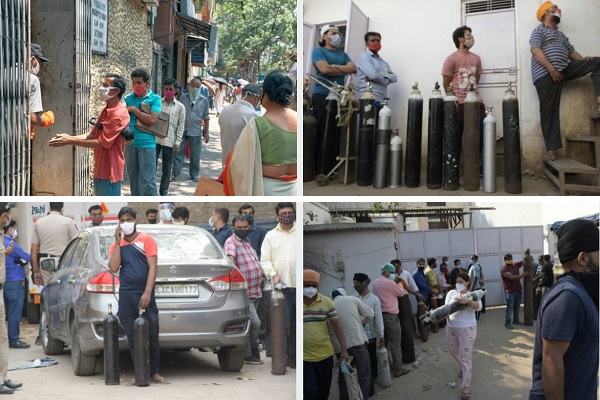Dec 18, 2025
Dec 18, 2025
Management of the humanitarian crisis caused by the second-wave of Covid-19 calls for sagacious leadership.
It is shuddering to watch the heart-breaking scenes on TV screen. Seeing people with Covid-19 symptoms lining up in front of testing centers right from 4 am, ambulances with blaring sirens racing down from hospital to hospital with Covid-19 patients, long line of ambulances with patients waiting for beds in front of hospitals, people lining up in hospital corridors for medication and oxygen to relieve their virus-affected lungs, and queues of dead bodies at the cremation grounds waiting for space amidst countless funeral pyres, every Indian is silently praying for a way out from the crisis.
All this happened within a matter of few weeks—after a dramatic reduction in hospital utilization rates by January 2021, a misplaced confidence that the worst is over perhaps led to a sudden surge in cases. Further, fanned by huge gatherings at events such as Basant (new year) festival, celebration of the first day of Ramadan with friends and relatives, huge gatherings at Kumbh Mela in Haridwar, massive election rallies across the country, and the very indifference of people to observe the basic Covid-19 appropriate behavior, etc., the daily count of people testing positive for Covid-19 reached an all-time high of 4.14 lakh on May 7, 2021 a global record.

Did any of us ever imagine that India of 2021 whose spacecrafts orbited Moon and Mars, which manufactures oxygen on an industrial scale and even exports, would let its people die in and outside of hospitals in want of oxygen to breathe? Still worse is watching the quarrels between the governments over oxygen supply—the blame-games in the Court halls.
Observing the death of Covid patients due to non-supply of oxygen, the Allahabad High Court termed it as a ‘criminal act’ and nothing short of ‘genocide’ on the part of those entrusted to ensure oxygen supplies. The Delhi High Court came down heavily on Center over its failure to supply 700MT oxygen per day to the Delhi government as assured earlier, by directing the central government to show-cause why contempt action should not be taken for non-compliance of their order of May 1 and Supreme Court order. It is, of course, a different matter that when the Center contested it in the Supreme Court, it stayed it. Nevertheless, it emphasized that the central government has to increase supply of medical oxygen to Delhi government and also directed it to place before it a plan of action to comply with its order.
Over it, the Principal Scientific Adviser to the government, K Vijay Raghavan addressing a Union Health Ministry press conference, said: “Third phase is inevitable given the amount of virus circulating. But it is difficult to predict the timeline. We should prepare for the new (third) wave”, which raised fear and anxiety among the hapless people. And the all-round absence of compassion for the suffering lot has further worsened the impact of the pandemic on the nation as a whole.
Amidst this chaos, there came a ray of hope: the Mumbai Municipal Corporation headed by its Commissioner Iqbal Singh Chahal came up with a Hub and Spoke model to manage the crisis caused by the ferocious second wave. The model constituted a Hub—a Central control room at BMC headquarters—assisted by 24 war rooms, located one in each civic ward. Each ward center was provided with 30 telephone lines, 10 telephone operators and 10 dashboards with information about availability of hospital beds in Mumbai. They were also provided with ten doctors, supporting medical staff and 10 ambulances. Medical interns were recruited from all over the State to man these control rooms by paying a stipend of Rs 50 000/- per month. Similarly, nurses were appointed from various nursing schools. They were provided decent accommodation nearer to the control rooms. These teams worked 24 hours in three shifts.
Testing laboratories were asked not to inform the Covid-19 test results to patients but to pass them on directly to the Central Control Room at BMC headquarters. The Central control room in turn passed on the test results— on average 10000 reports are received per day from 55 testing labs— to the respective control rooms located in the wards by 6 am next day. Then the medical teams from the area control rooms fanned out to respective peoples’ residences who tested positive with ambulances that were guided by Uber GPS platform to evaluate their condition and if required ascertain from control room for oxygen-bed or ICU bed as the situation demanded and send them to hospital by the same ambulance. The rest are kept in home quarantine with regular medication and check-up. Even cremation of the dead was arranged in dignity by allotting cremation slots through an online dashboard created by IIT covering Mumbai’s 47 crematoriums.
This careful planning, quick action to manage the emerging situation aided by a powerful feedback loop had calmed the nerves of the citizens. For, Chahal’s model is responsive to and compassionate of the Covid patients, which is glaringly missing in the rest of the country. The state government too must be complimented for its undivided support, both financially and politically.
Of course, Mumbai corporation, even otherwise, is the richest corporation in India with a budget bigger than even some of the States, and that must have come quite handy for Mr Chahal to quickly create the necessary infra. That said, we cannot afford to ignore the pivotal force behind the success of this model: Sagacious leadership of Mr Chahal.
No wonder, the Supreme Court of India, appreciating the BMC model, advised the Centre to examine it for adoption. But what matters most here is not the model but Chahal’s gutsy and dynamic leadership that enabled him to enjoy the dedication of his whole team for the cause. But unfortunately, such a tribe is less in numbers today!
15-May-2021
More by : Gollamudi Radha Krishna Murty